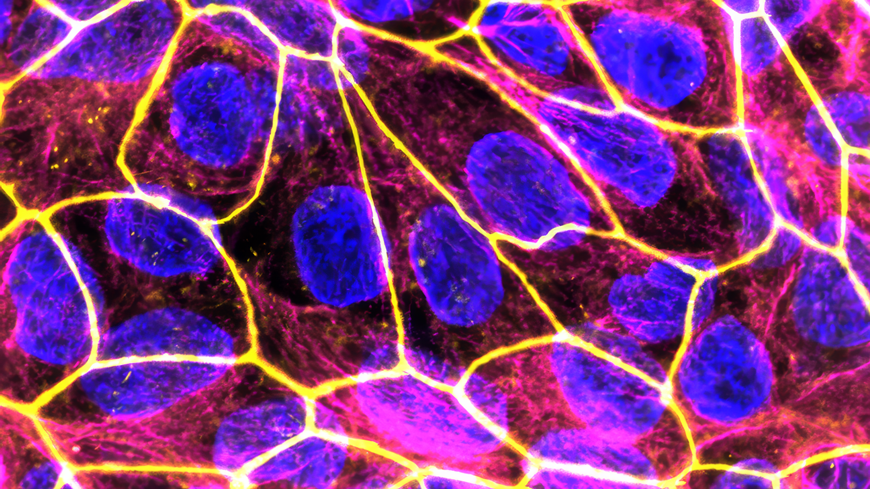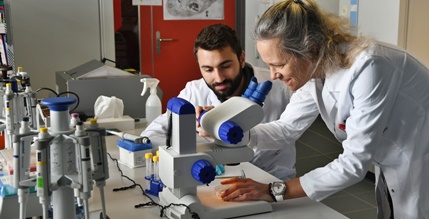Nanomedicine for treatment of inflammation in pregnancy
Safe medication for mother and child
Special care must be taken with illnesses during pregnancy, as not all drugs are compatible for mother and child. This is why an international research team involving Empa is now developing nanomedicines that will enable safe and effective treatment of inflammatory processes during pregnancy. Pregnancy complications are often caused or accompanied by inflammation, but the treatment options are often not sufficiently effective or are suspected of interfering with the development of the foetus.

When complications occur in the course of a pregnancy, it is not only the mother's life that is at risk, but also that of the unborn child. But what can be done when medication against widespread infections and other pregnancy complications such as pregnancy poisoning, diabetes or the threat of premature birth is either ineffective or too risky?
Medical research has a possible answer: nanozymes. The tiny synthetic particles could help treat inflammatory processes in the placenta without harming mother or child. A team of researchers from Empa, ETH Zurich, the Cantonal Hospital of St. Gallen and the Chinese Zhejiang University is now developing novel nanozymes in a project funded by the Swiss National Science Foundation (SNSF). The development process is accompanied by comprehensive studies on drug safety.
A modular toolkit for safe therapies

Nanozymes are tiny synthetic compounds in the nanometer range with enzyme-like properties that are already being investigated in other medical fields, such as cancer therapy. They are made up of a nanostructured core (e.g. metal atoms or metal oxides), which determines the particle's enzymatic activity, and surface modifications that increase the stability of the nanozymes and improve their specificity. “In this way, we want to enable customized use for different areas of application,” explains Empa researcher Tagaras.
The activity of the nanozymes changes depending on the prevailing disease processes in the area of application: From a stealth mode, a kind of inactive state, they can become active in order to capture reactive oxygen species (ROS) in inflammatory processes, for example, or to destroy bacteria in the event of an infection.
The development of the nanozymes is accompanied by laboratory experiments on the safety of the new drugs. Here, the researchers in the Empa laboratories use established models that faithfully reproduce what happens in the placenta and in the organism of both mother and child. “The structure, metabolism and interaction of maternal and fetal tissue are unique in humans,” says team leader Tina Bürki from Empa's Nanomaterials in Health laboratory in St. Gallen. It is therefore necessary to investigate the effect of the nanozymes on laboratory models with human cells and tissues. The established placenta model is used here, for which the team uses fully functional human placentas that were made available after Caesarean sections. “Only thanks to human placental tissue can we obtain meaningful results on the transport and effect of the nanozymes,” says the Empa researcher.
A promising start
A further step towards safe nanomedicines is the so-called placenta chip, a finger-length polymer chip on which human cells grow that represent the placental barrier and the embryo in conditions that are as close to reality as possible. In addition to transport processes at the placenta, the direct and indirect effects of the nanozymes on early embryonic development can also be investigated in this way.
The initial results are promising. “The nanozymes do not impair the placental barrier and have so far shown no negative effects on the models studied,” says Empa researcher Tagaras. Next, the team will analyze the anti-inflammatory and antibacterial effects of the nanozymes.
Dr. Tina Bürki
Nanomaterials in Health
Phone +41 58 765 7696
Nikolaos Tagaras
Nanomaterials in Health
Phone +41 58 765 7054
N Tagaras, H Song, S Sahar, W Tong, Z Mao, and T Buerki-Thurnherr; Safety Landscape of Therapeutic Nanozymes and Future Research Directions; Advanced Science (2024); DOI: 10.1002/advs.202407816
Medical technology
Focusing on people: In the Research Focus Area Health, Empa researchers are developing pioneering solutions for the medicine of tomorrow – precisely where “conventional” materials meet living ones, i.e. cells and tissue. There are polymers that light up when there is an infection with certain germs, tiny gold particles against cancer or “nanozymes” that help mothers with complications during pregnancy without harming the foetus – and much more.
Read the latest EmpaQuarterly online or download the PDF version.
-
Share






